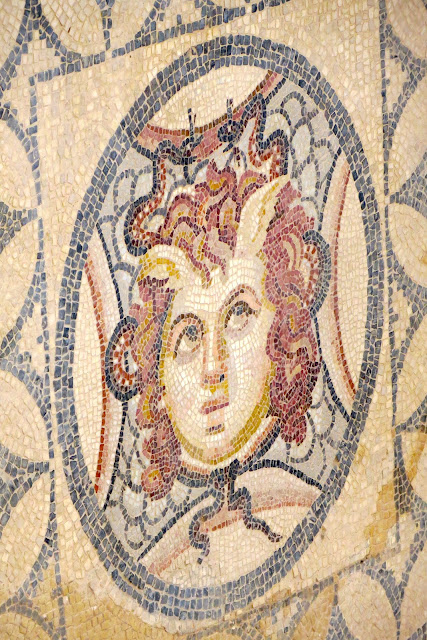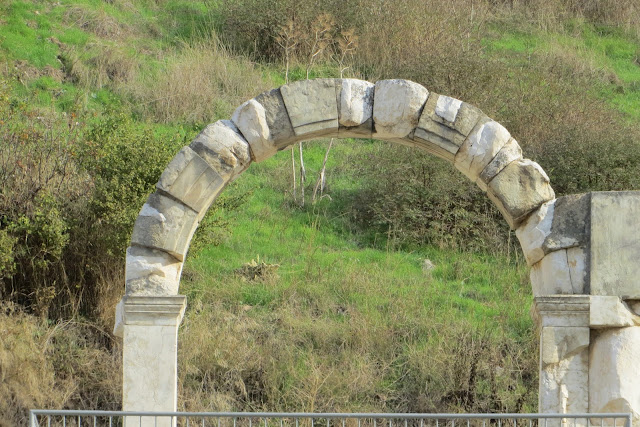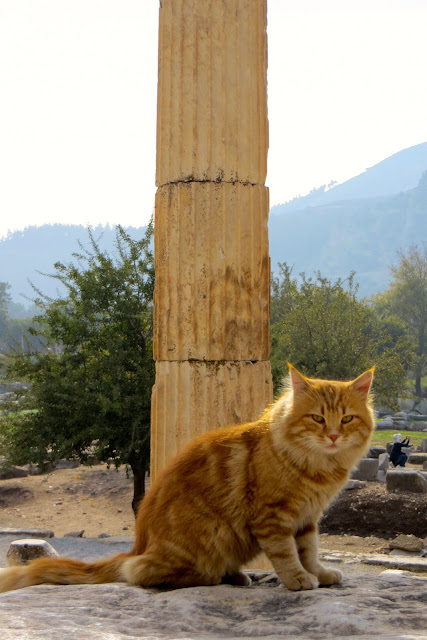Friday, Nov. 16
We were up before call to prayer this morning, our alarm rang at 3:50. These two travelers have a big day ahead, starting with a 7 am flight to Izmir. It was a very short flight-about 55 minutes. AtlasJet also has a shuttle bus service from the Izmir airport to the small town of Selcuk (pronounced Sel-chook). This was included in our ticket price--$38 (US) each round trip from Istanbul--sure wish we had low cost carriers like this at home!
The bus dropped us off right in the center of town, in front of this statue, a tribute to Mustafah Ataturk.
After the shuttle dropped us off, we needed to find a dolmush, a small local mini-bus, to take us to Ephesus. We found the right place, and here I am in our dolmush, ready to go to Ephesus:
The dolmush dropped us off in the lower parking lot, but we had decided that we wanted to reverse our visit, so we hopped in a taxi for the short ride to the top. We paid our reasonable admission, about $14 each--and it was worth every dollar, and then some!
My Mom and Dad had been to Turkey last year, and had really enjoyed Ephesus. And they were right--it is simply fascinating---one of our best travel days ever!
A little about Ephesus, from Izmir Tourist Bureau brochure:
"Evidence of the establishment of first settlement in the area dates back to 6000 BC. Recent surveys and excavations date several artifacts to the Bronze Age. Migrants from Greece settled in the city of Apasas around 1050 BC, and the ancient City of Ephesus was established in 300 BC by Lysimakhos, a general of Alexander the Great."
Starting at the top, we first saw the area around the baths, built about 2nd c. A.D. The terracotta pipes for running water and plumbing were really impressive, we saw this system all over Ephesus:
My Mom and Dad had been to Turkey last year, and had really enjoyed Ephesus. And they were right--it is simply fascinating---one of our best travel days ever!
A little about Ephesus, from Izmir Tourist Bureau brochure:
"Evidence of the establishment of first settlement in the area dates back to 6000 BC. Recent surveys and excavations date several artifacts to the Bronze Age. Migrants from Greece settled in the city of Apasas around 1050 BC, and the ancient City of Ephesus was established in 300 BC by Lysimakhos, a general of Alexander the Great."
Starting at the top, we first saw the area around the baths, built about 2nd c. A.D. The terracotta pipes for running water and plumbing were really impressive, we saw this system all over Ephesus:
The street in front of the Odeion, a small theatre:
David in passageway leading to the Odeion:
The Odeion, original excavations showed that this theatre was covered:

The countryside is really pretty, with beautiful green, rolling hills:
In every direction there are incredible treasures to see:
This area was pretty tough walking, lots of large rough stones in the path:
Unfortunately, this rooty plant caught my toe, and down I went! Landed on my "bad" knee, but was lucky that I only have a nice bruise and no permanent damage. Every trip for the past few years, I've had what I call my "Trip trip"--gazing around in wonder, not watching where I'm walking. Just one each trip, and I thought I was going to break that streak this time, but no such luck!
The offending root, darn thing!
After pulling myself together, we continued on to Hercules's Gate:
Looking back up Marble Road:
About now we're getting our first really good view of the Celsus Library, one of the best preserved and complete areas of Ephesus:
The Temple of Hadrian, from about 117-138 A.D. This temple was dedicated to Emperor Hadrian:
Detail of the pretty arch:
More detail:
Next up: The Latrina. According to the guide book, this area was part of the bathing and gymnasium complex, and was built as an open room, without any individual partitions. 1st c. A.D.
Our next stop: The Terrace Houses. This large complex is an active archeology dig, and has been entirely covered to protect it from the elements. The first dwellings were built 1st century B.C., and were last occupied about the 7th c. A.D.
Beautiful frescoes:

Overview, from one of the platforms:
Pottery:
In the same dwelling:
We saw many variations on black and white motif for floor mosaics:
This is one of the bath areas, note the "plumbing":
Another floor mosaic:
The Celsus Library was built between 100-110 AD. It was revealed in 1904 during excavations, and restored between 1970-1978.
The four statues in the front niches sympolize four virtues of Celsus: wisdom (Sophia), knowledge (Episteme), destiny (Erinoia), and virtue (Arete).
Looking up:
And here we are!

At the entrance to Celsus Library are the Gates of Mazeus and Mithridates. Mazeus and Mithridates were slaves under Emperor Augustus, were given their liberty, and in return had built these arches in gratitude.
Looking through the arches toward the Mercantile Agora:
Our last area to see, The Theatre. Built in the Hellenistic period, 3rd c. BC. It is the largest ancient theatre structure in Turkey, said to hold 24,000 people. It is massive:
And here we are!
One of the aspects of Ephesus that I enjoyed the most were the many, many architectural fragments scattered around. I've always been fascinated by them, especially the different design motifs. Here are a few of my favorites:
Two lion heads on this one:
Detail:
Another fun aspect of Ephesus are the cats! We have noticed many, many feral cats all over Istanbul, thousands of them--they are just everywhere! In the streets, parks and they even wander into the restaurants, sit by your table and gaze up at you, patiently waiting for food scraps. Of course, they always get a little something from us! The locals seem to love them, and we've noticed they put out plates of cat food for them. We even saw a gentleman at the Izmir airport feeding the cats!
Here are The Cats of Ephesus--I think they have the best "home" ever!
We walked along the path to the exit, and looked off into the distance--another amazing ruin! This one looked interesting:
We zoomed in on the top part--it's only a couple of stones keeping this intact:
We had spent almost 4 hours exploring the wonderful, incredible ancient city of Ephesus. What a treasure this place is! It was absolutely worth the flight and trip from Istanbul to see this special place.
The pretty tree lined path leading to the exit:
At the entrance/exit area of course there were many shops and a couple of restaurants. We stopped for a cold beer and a light snack--we were starving! No breakfast this morning, and we'd had quite a workout climbing all over Ephesus!
We caught the dolmush back to Selcuk, and roamed around the pretty streets looking for a lunch spot.
Stork nests on top of the aqueduct:
We'd spotted this castle on our way into town, and decided to walk up the hill in that direction.
The Ayasoluk Fortress, 5th c AD. They are currently restoring inside the walls, and it will be open to visitors in 2013.
Looking down into Selcuk:
Entrance to the Church of St. John:
We wandered back down the hill, exploring the little side streets. We stopped in a small "rug" shop, and I made the mistake of looking at some old textiles. After some hard bargaining, I came away with an old tribal ceremonial hat--child size.
In our travels in Turkey we've enjoyed the street cafe scene--but it's always the men sitting around, drinking tea or Turkish coffee, gossiping and playing backgammon or other games. The women must be at home working!
Our AtlasJet shuttle to the Izmir airport wasn't until 7:15, so we had time for a quick dinner. We found a cute little cafe with outdoor seating and settled in for a nice dinner. They gave us nice crusty bread to dip in this olive oil/herb mix, and the black olives were really good:
A mixed vegetable plate--really yummy, smoky eggplant, peppers and onions. The usual really good yogurt on the top:
We shared this combination shish kapab plate, it was all very tasty, except for those long green peppers. We assumed ( I know, I know!!) they were the same kind of pepper we've been eating all along--but we were WRONG! They were very, very hot--too hot for us!
After our dinner we still had almost an hour to kill, we strolled the streets a bit, and then decided we were just plain t-i-r-e-d! We'd been up since 3:50 this morning and had a long, tiring but totally wonderful day. So we walked the short block to our shuttle stop, sat down on a nearby park bench, cuddled up and relaxed!
Our bus arrived right on time, it was a 45 minute ride to Izmir--and I had a little nap along the way.
After our quick flight to Istanbul, we were back "home" to our apartment by about 11:30, and just fell into bed.
One of our BEST travel days ever!

























































































Wow, Ephesus is amazing!! It would be quite an experience to be able to see all of this in person. Loved the pictures of the cats and they all seemed to be striking a pose just for you. You had a long day and I bet you were on sensory overload by the end of the day with all the amazing sights.
ReplyDeleteI wonder what it would be like to live in an area where you have all that ancient history surrounding you every day.... it must be so humbling. Hope that your knee doesn't act up following your fall. Sorry that this seems to be a tradition. Get some rest and enjoy the remainder of your trip. Hugs to you and Dave.
ReplyDeleteI agree with Sherry...Ephesus is amazing. The plumbing, the theatres...even the food looked good. But I especially liked seeing you two hugging in front of the library...I look forward to those pictures. The men have the good life there...and I bet the women are home working and cleaning. So it seems as we go about our daily lives...working, cleaning and grocery shopping that there's a magnificent world out there we forget about. Thanks for reminding us!
ReplyDeleteYes there is an amazing world out there, Dear Bren! I am so lucky to be able to explore and enjoy just a small part of it. WIsh I could tuck you in my suitcase!
DeleteWhat is it with cats and ruins?
ReplyDeleteEphesus looks awesome! I was amazed at the ruins and old buildings in Rome, but there's stuff at Ephesus that is over 8000 years old... insane!